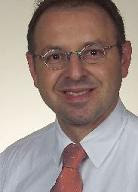 Making things visible that can not be seen with the naked eye? Overlaying personalized information onto objects or images? Such concepts make good fiction but are there interesting use cases? Michael Rohs from T-Labs in Berlin visited B-IT and Fraunhofer IAIS today and he showed us in his talk and demos several such scenarios that appear not to be far in the future or fictional anymore.
Making things visible that can not be seen with the naked eye? Overlaying personalized information onto objects or images? Such concepts make good fiction but are there interesting use cases? Michael Rohs from T-Labs in Berlin visited B-IT and Fraunhofer IAIS today and he showed us in his talk and demos several such scenarios that appear not to be far in the future or fictional anymore. Michael has developed during his PhD at ETH Zürich the Visual Codes system (http://people.inf.ethz.ch/rohs/visualcodes/) that provides a basis for augmented reality interaction on mobile phones. Some of his current work, in particular overlaying information on large paper maps, shows impressively the potential of using personal mobile devices, such as phones, as interfaces to combine static and dynamic information. I think for everyone trying out information overlays using a phone can easily imaging that this could be commonplace pretty soon. The question is more what the first pervasive and convincing applications are for mobile augmented reality and when will we find them in the wild. In our discussion a number of interesting application areas came up, in particular games and advertising seem very appealing.
In the morning Michael got a tour a B-IT and some demos. One of our tasks in the practical course developing location and context-aware systems is also related to a magic device from the Harry Potter book – a map with a moving point ;-)
Till Schäfers, a student at B-IT who is currently at T-Labs in Berlin for his master thesis (supervised by Michael and me) gave this morning a presentation on the work he started. We had a longer discussion on issues of teleconferencing – and in particular on mobile teleconferencing – were many interesting ideas and issues came up. (Remark on research&realty: somehow it is sad that even after many year of research in teleconferencing the tools we use to do meeting over the phone in our daily work are still poor – but things are getting better). Another issue we discussed in detail is the questions of how to involve the user in the design process even more while giving at same time the user interface designer the freedom to designs and defines novel ways of interaction and exciting interfaces.
 Besides the scientific exchange it is great to have visitors to learn about new gadgets. Michael and Till showed the SHAKE SK6 sensor /actuator attached to a phone – quite an interesting tool for research.
Besides the scientific exchange it is great to have visitors to learn about new gadgets. Michael and Till showed the SHAKE SK6 sensor /actuator attached to a phone – quite an interesting tool for research.
 Making things visible that can not be seen with the naked eye? Overlaying personalized information onto objects or images? Such concepts make good fiction but are there interesting use cases? Michael Rohs from T-Labs in
Making things visible that can not be seen with the naked eye? Overlaying personalized information onto objects or images? Such concepts make good fiction but are there interesting use cases? Michael Rohs from T-Labs in 


No comments:
Post a Comment